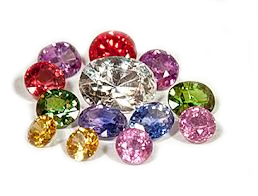Gemstones

Gemstone Clarity
Gemstone clarity relates to the amount of inclusions (trace elements or large particles of other elements or minerals) that a gem has. The less inclusions within the gemstone, usually the higher the quality and more expensive the stone is.
The majority of minerals, gemstones and specifically diamonds have small inclusions that lower there clarity. While there are many types of charts that can guide you to the ratings of gemstone clarity, it should be noted that most minerals will always have inclusions (Emerald and Rubies) and these inclusions will not necessarily devalue the gemstone, in fact in certain circumstances, inclusions are welcomed and will add value to a gemstone (e.g. Pyrite inclusions in Lapis Lazuli)
One of the important points to make when judging clarity is to judge it against the normal standard of that specific gemstone. Even a cloudy diamonds will usually have fewer inclusions than the highest priced Emeralds. Stay within the gemstone standard to figure out if the stone is less of a value due to its clarity.
One of the ways professional jewellers can give you a good idea on how clarity rates when measured against other specific gemstones is with the use of a Clarity Grading System. Most gemstone organizations create an easy to understand chart and grading system to reasonably grade any gemstone on clarity. Usually, when shopping for a gemstone at a jeweller, the stone may be stated as being in a clarity grade of the following.
Type I
Coloured stones include gemstones with very little or no inclusions. These can include Aquamarine, Topaz and Zircon, among others.
Type II
Coloured stones include gemstones that often has a few inclusions. They include Corundum, Garnets and Spinel, among others.
Type III
Coloured stones include gemstones that usually always has inclusions. Stones in this category include Emeralds, Tourmaline, etc.

